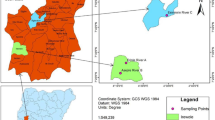Abstract
Only a limited number of phenotypic tests are available for the differentiation of all 13 known hybridization groups (HG) of Aeromonas spp. These organisms have a wide spectrum of warm-blooded and cold-blooded hosts. In the present study, the maximum growth temperatures (tmax) of the most common HGs of Aeromonas spp. originating from human fecal samples, food, water, and healthy and diseased fish were determined with a plate-type continuous temperature-gradient incubator. We observed that determination of the tmax can be applied for differentiation of HG 1 from HG 2 and 3 (phenospecies A. hydrophila); HG 6 from HG 4, 5A, and 5B (phenospecies A. caviae); HG 7 from HG 8/10 (phenospecies A. sobria); and HG 11 from HG 8/10 (phenospecies A. veronii). HG 1, 4, 8/10, and 13 strains occurring also in human clinical samples had a high tmax, about 40°C or higher. Hybridization group 2, 3, 5A, and 5B strains, which in most cases originated from water or food, had tmax values in the range of about 36–39°C, while HG 6, 7, and 11 had tmax values in the range of about 33–37°C. Fish pathogenic strains of A. salmonicida subsp. salmonicida and subsp. achromogenes had the lowest tmax values from about 30 to 35°C.
Similar content being viewed by others
References
Abbott SL, Cheung WKW Kroske-byström S, Malekzadeh T, Janda MJ (1992) Identification of Aeromonas strains to the genospecies level in the clinical laboratory. J Clin Microbiol 30:1262–1266
Altwegg M, Geiss HK (1989) Aeromonas as human pathogen. Crit Rev Microbiol 16:253–286
Altwegg M, Steigerwalt AG, Altwegg-Bissig R, Luthy-Hottenstein J, Brenner DJ (1990) Biochemical identification of Aeromonas genospecies isolated from humans. J Clin Microbiol 28:258–264
Carnahan AM, Behram S, Joseph SW (1991) Aerokey II: a flexible key for identifying clinical Aeromonas species. J Clin Microbiol 29:2843–2849
Carnahan AM, Chakrabotry T, Fanning GR, Verma D, Ali A, Janda JM, Joseph SW (1991) Aeromonas trota sp. nov., an ampicillin-susceptible species isolated from clinical specimens. J Clin Microbiol 29:1206–1210
George WL, Jones MJ, Nakata MM (1986) Phenotypic characteristics of Aeromonas species isolated from adult humans. J Clin Microbiol 23:1026–1029
Havelaar AH, During M, Versteegh JIM (1987) Ampicillin-dextrin agar medium for the enumeration of Aeromonas species in water by membrane filtration. J Appl Bacteriol 62:279–287
Havelaar AH, Schets FM, van Silhout A, Jansen WH, Wieten G, van der Kooij D (1992) Typing of Aeromonas strains from patients with diarrhoea and from drinking water. J Appl Bacteriol 72:435–444
Janda JM (1991) Recent advances in the study of the taxonomy, pathogenicity and infections syndromes associated with the genus Aeromonas. Clin Microbiol Rev 4:397–410
Kuijper EJ, Steigerwalt AG, Schoenmakers BSIM, Peeters MF, Zanen HC, Brenner DJ (1989) Phenotypic characterization and DNA relatedness in human isolates of Aeromonas spp. J Clin Microbiol 27:132–138
Kämpfer P, Altwegg M (1992) Numerical classification and identification of Aeromonas genospecies. J Appl Bacteriol 72:341–351
Liesenfeld O, Weinke T, Hahn H (1993) Three-year prevalence of enteropathogenic bacteria in an urban patient population in Germany. Infection 21:101–105
Martinetti Lucchini G, Altwegg M (1992) rRNA restriction patterns as taxonomic tools for the genus Aeromonas. Int J Syst Bacteriol 42:384–389
Martinez-Murcia AJ, Esteve C, Garay E, Collins MD (1992) Aeromonas allosaccharophila sp. nov., a new mesophilic member of the genus Aeromonas. FEMS Microbiol Lett 91:199–206
Mateos D, Anquita J, Naharro G, Paniaqua C (1993) Influence of growth temperature on the production of extracellular virulence factors and pathogenicity of environmental and human strains of Aeromonas. Appl Bacteriol 74:111–118
Moyer M (1987) Clinical significance of Aeromonas species isolated from patients with diarrhea. J Clin Microbiol 27:2044–2048
Niemela SI, Tubb R, Suominen H (1990) Temperature-gradient incubator, Gradiplate® W10 user's guide. Biodata Oy (Ltd) Helsinki, Finland
Niemi RM, Niemela SI, Bamford DM, Hantula J, Hyvärinen T, Forsten T, Raateland A (1993) Presumptive fecal streptococci in environmental samples characterized by one-dimensional sodium dodecylsulfate-polyacrylamide gel electrophoresis. Appl Environ Microbiol 59:2190–2196
Popoff M (1984) Genus III. Aeromonas Kluyver and Van Niel 1936, 398AL. In: Krieg NR, Holt JG (eds) Bergey's manual of systematic bacteriology, vol 1. Williams & Wilkins, Baltimore, pp 545–548
Popovic T, Bobb CA, Olsvik O, Kielbauch JA (1993) Ribotyping in molecular biology. In: Peshing DH, Smith TF, Tenover FC (eds) Molecular microbiology. Principles and application. American Society of Microbiology, Washington, D.C., pp 573–583
Schubert RHW (1991) Aeromonads and their significance as potential pathogens in water. J Appl Bacteriol Symp Suppl 70:1315–1355
Wadström T, Ljungh A (1991) Aeromonas and Plesiomonas as food- and waterborne pathogens. Int J Food Microbiol 12:303–312
Author information
Authors and Affiliations
Additional information
Correspondence to: M.-L. Hdnninen
Rights and permissions
About this article
Cite this article
Hänninen, M.L., Salmi, S. & Siitonen, A. Maximum growth temperature ranges of Aeromonas Spp. isolated from clinical or environmental sources. Microb Ecol 29, 259–267 (1995). https://doi.org/10.1007/BF00164889
Received:
Revised:
Issue Date:
DOI: https://doi.org/10.1007/BF00164889




